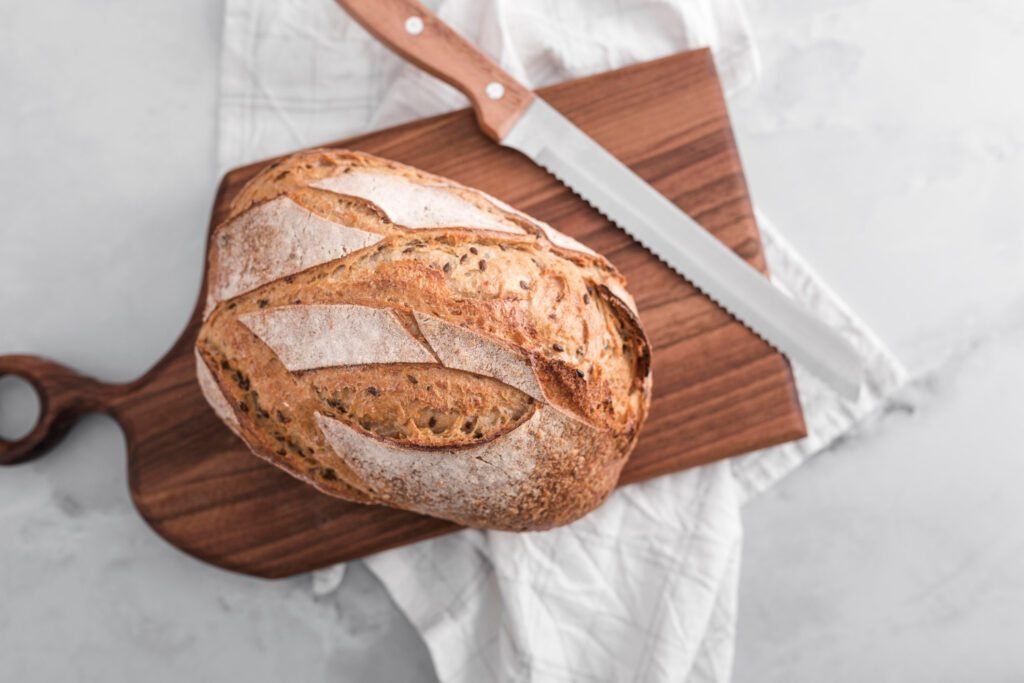There’s something magical about baking your own bread. The smell of freshly baked bread filling your home, the satisfaction of slicing through a golden crust, and the delight of biting into a soft, warm loaf – it’s an experience like no other. If you’ve ever wanted to bake bread like a professional baker, you’re in the right place. This guide will walk you through everything you need to know to master the art of bread baking.
Getting Started: The Essentials
Before you dive into baking, it’s important to gather the right tools and ingredients.
Tools:
- Mixing bowls
- Measuring cups and spoons
- Digital scale
- Dough scraper
- Bench knife
- Proofing basket (banneton)
- Dutch oven or baking stone
- Lame or sharp knife for scoring
- Cooling rack
Ingredients:
- Flour (bread flour, all-purpose flour, whole wheat flour)
- Water
- Yeast (active dry yeast or instant yeast)
- Salt
- Optional: sugar, honey, olive oil, seeds, nuts
Step-by-Step Bread Baking Process
- Choose Your Recipe: Start with a simple recipe, like a basic white or whole wheat bread. As you become more comfortable, you can explore more complex recipes.
- Mixing the Dough: Combine your ingredients. Here’s a basic formula:
- 500g flour
- 350g water (70% hydration)
- 10g salt
- 2g yeast Mix until all ingredients are combined and you have a shaggy dough.
- Autolyse: Let the dough rest for 20-30 minutes. This helps hydrate the flour and starts gluten development.
- Kneading: Knead the dough until it becomes smooth and elastic. This can take about 10-15 minutes by hand or 8-10 minutes in a stand mixer.
- First Rise (Bulk Fermentation): Place the dough in a lightly oiled bowl, cover it with a damp cloth or plastic wrap, and let it rise until it doubles in size. This usually takes 1-2 hours depending on the room temperature.
- Shaping the Dough: Turn the dough out onto a lightly floured surface. Gently deflate it and shape it into a round or oblong loaf. Place it seam side up in a floured proofing basket or on a floured kitchen towel.
- Second Rise (Proofing): Let the shaped dough rise until it has increased in size and passes the “poke test” – a gentle poke should slowly spring back. This can take 1-2 hours.
- Preheating the Oven: Preheat your oven to 450°F (230°C). If using a Dutch oven, place it in the oven to heat up as well.
- Scoring the Dough: Carefully turn the dough out onto a piece of parchment paper or a floured baking peel. Use a lame or sharp knife to score the top of the dough. This allows the bread to expand properly in the oven.
- Baking:
- Dutch Oven Method: Place the dough (with parchment) into the preheated Dutch oven, cover with the lid, and bake for 20 minutes. Remove the lid and bake for an additional 20-25 minutes until the crust is deep golden brown.
- Baking Stone Method: Transfer the dough directly onto the preheated stone, add steam to the oven by pouring water into a preheated pan at the bottom, and bake for 30-35 minutes.
- Cooling: Remove the bread from the oven and let it cool on a wire rack for at least an hour before slicing. This ensures the crumb sets properly.
Tips for Perfect Bread
- Hydration: Higher hydration doughs (more water) can create a more open crumb with larger holes, which is desirable in artisanal bread.
- Temperature Control: Keep an eye on your dough’s temperature. Cooler dough will rise slower, while warmer dough will rise faster.
- Steam: Adding steam during the first part of baking helps develop a crisp crust. You can achieve this with a Dutch oven or by adding water to a pan in the oven.
- Practice Patience: Don’t rush the process. Allowing adequate time for fermentation and proofing is key to developing flavor and texture.
Common Bread Baking Issues and Solutions
- Dense Bread: This can be due to under-kneading, not allowing the dough to rise long enough, or using too much flour.
- Flat Loaf: Often caused by over-proofing or not scoring the dough properly.
- Burnt Crust, Undercooked Interior: Try lowering the oven temperature slightly and baking longer, or ensure your oven is properly calibrated.
Delicious Bread Recipes to Try
- Classic White Bread:
- Ingredients: 500g bread flour, 320g water, 10g salt, 7g yeast.
- Method: Follow the basic steps outlined above.
- Whole Wheat Bread:
- Ingredients: 250g whole wheat flour, 250g bread flour, 350g water, 10g salt, 7g yeast.
- Method: Same steps, with a slightly longer bulk fermentation for more flavor.
- Sourdough Bread:
- Ingredients: 500g bread flour, 375g water, 10g salt, 100g active sourdough starter.
- Method: Mix ingredients, autolyse, stretch and fold during bulk fermentation, shape, and proof overnight in the fridge. Bake as described.
FAQs
Q: How do I store homemade bread? A: Store your bread in a paper bag or wrapped in a clean kitchen towel to keep the crust crisp. For longer storage, slice and freeze the bread, then toast slices as needed.
Q: Can I use all-purpose flour instead of bread flour? A: Yes, but bread flour has higher protein content, which helps with gluten development and creates a better structure.
Q: What if my dough isn’t rising? A: Check your yeast’s expiration date, ensure the dough is in a warm place, and give it more time. Cooler temperatures slow down the rise.
Q: How do I get a really crisp crust? A: Bake with steam for the first part of the baking process and ensure the oven is preheated properly.
Final Thoughts
Baking bread is a rewarding and delicious skill to master. With practice and patience, you’ll soon be turning out loaves that rival those from professional bakeries. Remember, every loaf is a learning experience, so don’t be afraid to experiment and adjust based on your results.
So, roll up your sleeves, preheat that oven, and start baking like a pro!

